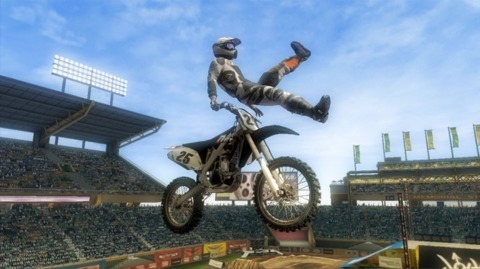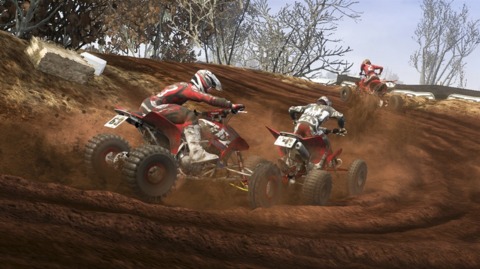MX vs. ATV Reflex: Freestyle, Deep Grooves, and David Lee
Just because you can do a trick in the upcoming MX vs ATV Reflex from THQ and developer Rainbow Studios, doesn't mean the trick actually exists in real life. Yet. During a recent visit to GameSpot HQ, reps from Rainbow (the folks behind the long-running MX vs. ATV series) said that some of the...
Just because you can do a trick in the upcoming MX vs ATV Reflex from THQ and developer Rainbow Studios, doesn't mean the trick actually exists in real life. Yet. During a recent visit to GameSpot HQ, reps from Rainbow (the folks behind the long-running MX vs. ATV series) said that some of the tricks you can pull off in Reflex are possible in real life, but haven't yet found a rider brave enough to attempt them. That said, the tricks can be spectacular--the Twister, for example, has the rider holding on to his bike by one handlebar, as he lengthens and twists his body out to the side. There's another that looks a bit like the rider is break-dancing on top of his handlebars, swinging his legs in quick circles before settling back down in the saddle and landing his bike.
In past versions of the MX vs ATV series, simply landing those tricks was tough enough--in my case, it seemed like I managed to spill my rider onto the dirt roughly half the time. Yet landing is easier than ever in Reflex, thanks to the so-called rider-reflex system. Here, when you get close to crashing out, an arrow flashes on screen, indicating you to push the right stick in the direction of the arrow. Do it within the timing window, and you'll right your rider's body on the bike or ATV and prevent a vicious crash.
Instead of using complex combinations of buttons and triggers to pull off tricks, stunts have been simplified in Reflex--to pull off a trick you simply hold the trick modifier button (LB on Xbox 360, L1 on PS3) and then flick the right stick in three distinct direction (such as up, down, left as opposed to up, up, down). Different combinations of right stick movements will result in different tricks and the game's judging system--which will judge your performance not just on the types of tricks you pulled off, but the flow of your tricks, how often you repeat tricks, and so on.
Still, the best part of Reflex's Freestyle mode has to be the announcer. If you've ever seen a commercial for a monster truck rally (and being from Alabama, I've seen plenty) you know the guy I'm talking about. He starts very quietly and THEN GRADUALLY RAMPS IT UP UNTIL IT'S SO INTENSE HIS HEAD IS GOING BLOW UP OHMYGODLOOKOUT!!!!! Yeah, that's the one. His name is David Lee and in addition to being the voice of several motorsport events, he'll be doing his thing throughout the game.
Moving on from perhaps the finest voice talent of our generation, I had a chance to try out Reflex for myself, both in the aforementioned Freestyle mode, as well as with the game's expansive open-world environments. One such lcoale was Reyes, Az., a mostly dry and mountainous area, with lots of elevation changes, as well as a hodgepodge of different surface types to explore the game's sophisticated terrain deformation system. We saw the feature--which kicks up dirt, mud, and snow until persistent grooves are left in the ground--back at E3 2009, but it's come a long way since then. Not only are the grooves in the ground deeper and the corresponding piles of kicked-up dirt higher, but there are some interesting side-effects that happen depending on the environment you're riding in.
For example, when doing doughnuts the muddy bank of a lake in the Reyes locale, we dug grooves deep enough to cause pools of water to appear in the grooves we created. Later in the demo, during a circuit racing taking place at a track set in Texas, the deep grooves from the many riders cutting sharp turns at the bottom of a steep hill cut into the water table, creating pools of water and potential havoc for the riders racing through it. Terrain deformation looks to have a huge effect in races, particular circuit races, in Reflex, as each successive lap will result in a changing track surface and different racing lines as a result.
As for the rest of the demo, I spent time checking out Omnicross mode, which essentially allows every vehicle type in the race together--from dune buggies to ATVs and all points in between. Omnicross events will take place across all the game's locales--and the circuit racing sections will feature mixtures of pinch point sections that will require the competitors to bunch up together, and more wide open sections where players can really let loose on the throttle.
I also had a chance to check out both the PSP and DS versions of Reflex, both of which are being developed by Australian developer Tantalus Studios, who previously developed the PSP version of MX vs. ATV Unleashed: On the Edge. The PSP version puts rider reflex controls on the shoulder buttons and vehicle steering on the d-pad and stunts are controlled first by pressing the triangle button and then using combinations of the shoulder buttons and d-pad. The PSP tracks and courses are based on the environments from the 360 and PS3 version of the game, though not the exact same layouts. As for the DS version, the big news will be the presence of Monster Trucks as playable vehicles exclusive to that version. Hopefully that version will also use the David Lee as voice guy because, you know, David Lee makes everything better.
MX vs. ATV Reflex is due for release on all platforms later this year.
Got a news tip or want to contact us directly? Email news@gamespot.com


Join the conversation